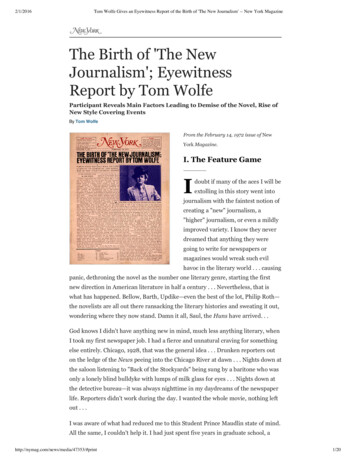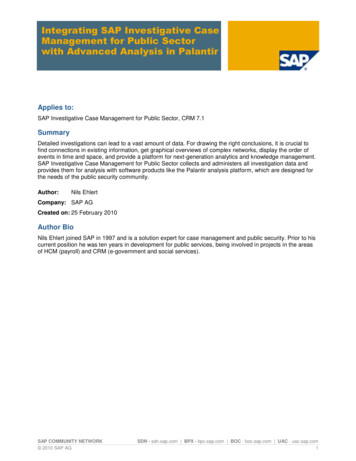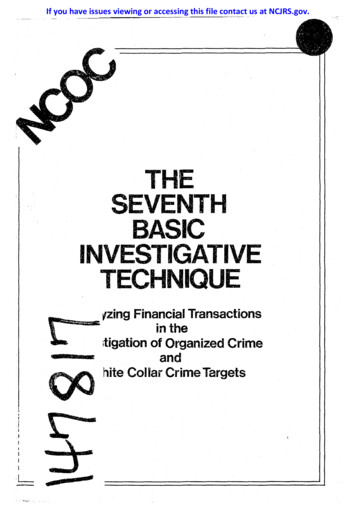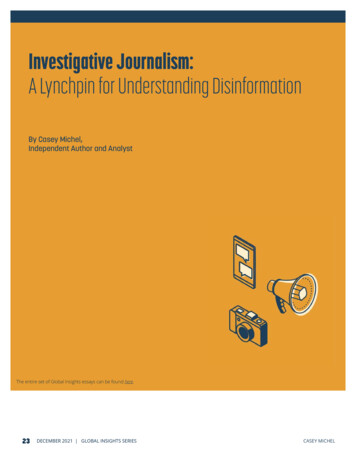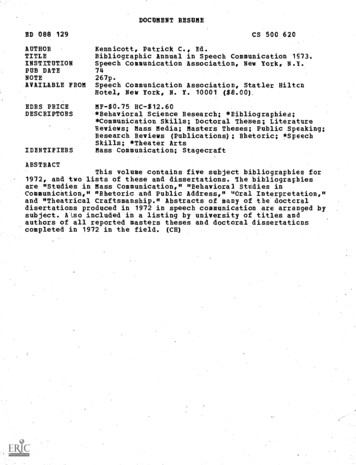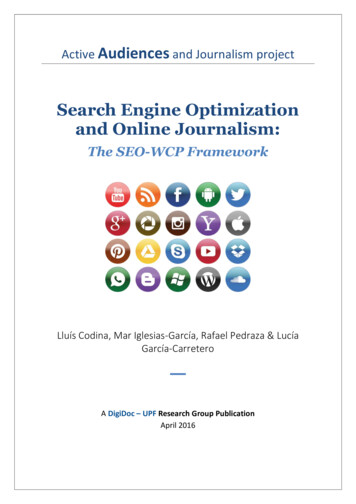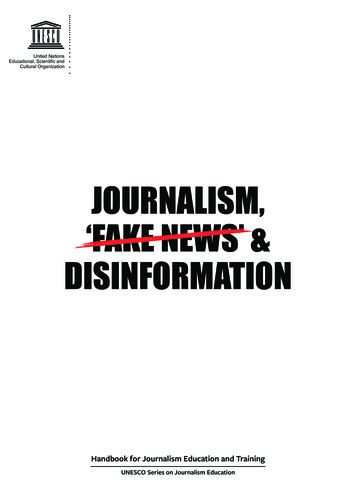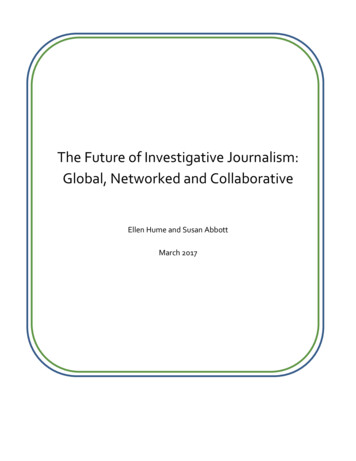
Transcription
The Future of Investigative Journalism:Global, Networked and CollaborativeEllen Hume and Susan AbbottMarch 2017
Note: This report is extracted from our recent evaluation of the Global Investigative JournalismNetwork (GIJN) for the Adessium Foundation. Ellen Hume would like to thank especially DavidKaplan, Susan Abbott, Anya Schiffrin, Ethan Zuckerman, James Hamilton, Tom Rosenstiel,Bruce Shapiro, Marina Guevara Walker and Brant Houston for their insights.2
1. Overview: The Investigative Media LandscapeThe internet and DIY communication tools have weakened the commercial mainstream media,and authoritarian political actors in many once-promising democratic regions arecompromising public media independence. Fewer journalists were murdered in 2016 than theprevious year, but the number of attacks on journalists around the world is “unprecedented,”according to the Index on Censorship. 1 Even the United States, once considered the goldstandard for press freedom, has a president who maligns the mainstream news media as“enemies of the people.”An unexpectedly bright spot in this media landscape is the growth of local and cross-borderinvestigative journalism, including the emergence of scores of local nonprofit investigativejournalism organizations, often populated by veterans seeking honest work after their oldorganizations have imploded or been captured by political partisans. These journalism “specialforces,” who struggle to maintain their independence, are working in dangerous environments,with few stable resources to support them.Despite the dangers and uncertainties, it is an exciting time to be an investigative journalist,thanks to new collaborations and digital tools. These nonprofits are inventing a potent form ofmassive, cross-border investigative reporting, supported by philanthropy. They are discoveringthat they are more secure and powerful in their watchdog work when they work togetheracross borders. Despite this so-called “post-fact” era of “fake news” and propaganda spreadvirally on the internet, these investigative journalists are having a powerful watchdog impact onpublic life with projects like the Panama Papers. They are developing new digital tools to cast aspotlight on corruption and injustice, with an international impact never before dreamedpossible.Global Investigative Journalism Network Executive Director David E. Kaplan’s definitive 2013survey for the Center for International Media Assistance, Global Investigative Journalism:Strategies for Support (CIMA, January 14, 2013) concluded that just 2% of the nearly 500million spent on international media assistance annually went to investigative journalism. Hewas concerned that donors might be so interested in exciting new digital and data tools thatthey might fail to support systematic investigative reporting, which also requires a humanelement, to dig out secrets using forensic techniques, and provide meaning and context.Kaplan’s 2013 report, together with a follow up analysis Kaplan co-authored in March 2016 withDrew Sullivan of OCCRP, are credited with helping to build the case for investigative journalismas a return on foreign aid investment. 2 Their argument was advanced further by tedattack-russia-turkey-ukraine2“Investigative Journalism & Foreign Aid: A Huge Return on Investment,” David Kaplan and DrewSullivan, GIJN.org, updated March 17, 20163
University scholar James Hamilton’s 2016 study, Democracy’s Detectives: The Economics ofInvestigative Journalism. Hamilton concluded that for each dollar invested in an investigativestory in the USA, there can be over 100 benefits to society. 3 Thanks in part to this kind ofresearch, and widely published international exposés such as the Panama Papers, investigativejournalism has attracted increasing support. It has even reached Hollywood: the movie“Spotlight,” about the Boston Globe’s investigation of the Catholic Church sex abuse scandal,won the top Oscar in 2016. Ironically, the movie’s 20 million budget was about ten timesgreater than the reporters had for their initial Spotlight investigation.4The US State Department’s Bureau of Democracy, Human Rights and Labor in 2016 allocated 3 to 5 million to the Organized Crime and Corruption Reporting Project and TransparencyInternational over the next three years for a project aimed at advancing investigative anticorruption journalism with training and other support. Another example of increased USGdonor interest is USAID’s recent five-year 6 million media development project in Moldova,which had a major focus on investigative journalism and anti-corruption activities. This growingUSG support for investigative journalism is not without controversy. GIJN, ICIJ and otherprominent investigative journalism organizations decline taking any US government money inorder to ensure their credibility as independent operations. “Yes, we are worried about themuch bigger need than money that is available. But USG is stepping in and disrupting themarket. I’m not happy with that,” said one GIJN member.The biggest source of media development money has beenUSAID, followed by George Soros’s Open SocietyFoundations (OSF), and the US State Department.5 What theUS government will do with this under President DonaldTrump and a Republican budget-cutting Congress isuncertain, and this political shift is likely to reduce USGmedia development funding after the current fiscal year endsin September, 2017. This could slow down the heated growthof nonprofit organizations in the media developmentsector. 63“Measuring investigative journalism’s impact on society: 8 good questions with James Hamilton,” LaurieBeth Harris, American Press Institute, Oct. 20, 2016. For a larger discussion of measuring impact, seeHamilton’s 2016 book, Democracy’s Detectives: The Economics of Investigative Journalism (Harvard, 2016)See also Anya Schiffrin and Ethan Zuckerman, “Can We Measure Media Impact? Surveying the Field,”Stanford Social Innovation Review, Fall 2015.4James Hamilton, Democracy’s Detectives, ibid, p. 835Kaplan interview with Hume, ibid6See for example, USAID and the Future of Media Assistance and Overseas Democracy Funding,available at nding.htm, 21 December 2016 (David Kaplan is one of the interviewees)4
CASE STUDY: THE PANAMA PAPERSGlobal massive electronic leaks are the new normal. Investigative journalists may start withleaked material but must then check it out, to discover the context and meaning of the databefore they can publish a fair expose. The Panama Papers were the biggest leak in history,leading to the largest international investigative journalism project of all time. It consisted of 11.5million documents, or 2.6 terabytes of information, sent by encrypted emails to one reporter,Bastian Obermayer, of the Suddeutsche Zeitung newspaper in Munich, Germany. The dataincluded one Panama law firm’s records of 214,000 offshore companies, including the names ofthe real owners, passport scans, bank statements and email chains. 7When the emails first started coming to Obermayer in Munich in April 2015, he realized veryquickly that he couldn’t parse all these documents alone. He turned to the InternationalConsortium of Investigative Journalists (ICIJ) in Washington, D.C., which had previously done bigcross-border projects. ICIJ was the natural place for Obermayer to turn. It is a Washington, D.C.based group of about 200 elite reporters, starting from a core of Nieman and Knight fellows andPulitzer Prize winners, who selectively invite new colleagues. The new recruits are trained to worktogether on projects selected by the ICIJ leadership.At the Global Investigative Journalism Network (GIJN) conference in Lillehammer in October, ICIJleaders met on the side to figure out how to proceed with this new Panama Papers project. ICIJand GIJN are closely related; ICIJ ‘s deputy director is the treasurer of GIJN’s board and GIJNexecutive director David Kaplan used to run ICIJ. GIJN is a global support network of investigativejournalism nonprofits, training and enabling far-flung journalists to meet at face-to-faceconferences.The Panama Papers investigation involved more than 400 journalists in 70 countries, all workingsecretly on the data for an agreed upon-publication date of April 3, 2016.This networked, horizontal, collaborative model of investigative journalism required thatjournalists from far away countries, who may not know each other, establish a working trustrelationship. They also needed expertise not easily gotten at home. ICIJ developed a privateversion of Facebook—iHub—for all the data to be posted for the participating reporters. A versionof the Tinder dating app was invented to allow reporters to decide whom to partner with on anygiven piece of the investigation.ICIJ’s Panama Papers team has exposed the offshore holdings of people in 200 countries,including 12 current and former world leaders. Some, like Vladimir Putin in Russia and NawazSharif in Pakistan have survived the embarrassing revelations. But Icelandic Prime MinisterSigmundur Davio Gunnlaugsson had to resign, as did Spain’s minister of industry. Manyprosecutions were initiated, and five EU countries agreed to share tax and law enforcement datain the wake of the revelations. The Panama Papers database is still being explored, and reporterslook forward to new data dumps for future cross-border investigations.7The Panama Papers, Bastian Obermayer and Fredrich Obermeier, (OneWorld Publications, June 30,2016)5
USG and private donors interviewed for this report were reluctant to predict how long theirdonor interest in investigative journalism would last. But they said the popularity ofinvestigative journalism projects is still on the upswing, and will continue well beyond 2017,attracting more private as well as public support for the sector.One challenge for funders is the measurement of impact for their grants. A growing body ofscholarship, including Hamilton’s, advances models showing that every dollar of money spenton investigative journalism returns multiple dollars in public goods. 8The growth of the Global Investigative Journalism Network (GIJN) in the past five yearsillustrates a trend towards international collaboration, resource sharing and advocacy. Media,communication and tech platforms in general are both part of the problem and part of thesolution to such issues as cross-border corruption and xenophobia.8See for example, Anya Schiffrin and Ethan Zuckerman, “Can We Measure Media Impact? Surveying theField,” Stanford Social Innovation Review, Fall 2015.6
What is Investigative Journalism?While all good journalism should be fact-checked and contextualized, investigativejournalists are the “special forces” of the profession. They are deployed to go more deeplyand systematically into an issue than their beat colleagues do. GIJN Executive Director DavidKaplan estimates that there no more than a few thousand professional investigativejournalists in the world. He emphasizes that these are not “leak reporters” who simply passon information leaked to them by WikiLeaks or someone else. (Leaks are often the rawmaterial, but only beginning, of the investigative journalist’s work.) Nor are they thebroadcasters of viral social media posts, however legitimate those might be. Instead,according to Kaplan, they are doing “systematic, in-depth, original research and reporting,often involving the unearthing of secrets.”Their work usually depends on the heavy use of public records, computer-assisted datacrunching, and a focus on social justice and accountability. Investigative journalism reliesheavily on primary sources. It involves the forming and testing of a hypothesis, and rigorousfact-checking. Such journalism therefore requires data skills and other specialized training.However the data alone do not tell the story, so investigative reporters also must piecetogether the human threads, figuring out the story’s context, proportionality and meaning.Investigative journalism is often dangerous and hard to fund, because it exposes wrongdoingby powerful elites. It is time consuming, expensive, and its independence must beunimpeachable.“Corruption can be an authoritarian government’s greatest political vulnerability,” US AssistantSecretary of State Tom Malinowksi testified in Congress. “Such governments can sometimesmanufacture excuses for shooting demonstrators, arresting a critic, or censoring a newspaper,but no cultural, patriotic, or national security argument can justify stealing.” 9 David Kaplanobserved that Investigative journalists can have a deterrent effect, as scarecrows, as well as awatchdog effect, uncovering crimes whose facticity cannot be denied.Until a few years ago, there were essentially three models of investigative journalism. Theseincluded 1) reporters at established news organizations, like the Boston Globe’s Spotlight team;2) small independently funded strike teams who work with primarily mainstream media to getthe word out, like ProPublica’s work with The New York Times; and 3) independent nonprofitorganizations that publish on their own. And now there is a fourth model: powerful,coordinated networks of these journalists, like the Washington-based International Center forInvestigative Journalism and the Organized Crime and Corruption reporting Project (OCCRP) inSarajevo. The Global Investigative Journalism Network) supports all four types of investigativejournalists, but it is having particular impact with the third and fourth models, in which nonprofit organizations work both independently and in cross-border networks, creating exposeslike the Panama Papers that can be important “locally,” i.e., both locally and globally.9Testimony before the Senate Foreign Relations Committee, June 30, 2016.7
2. The umbrella support network: GIJNThe Global Investigative Journalism Network (GIJN) has grown to a capacity-building supportnetwork of 145 nonprofit investigative journalism organizations in 62 countries. It works to raisethe standards and funding for investigative journalism worldwide, with an emphasis on thedeveloping world. GIJN trains and connects hundreds of journalists at each of its annualconferences, enabling reporters to meet foreign counterparts face to face, and establishingtrust for future cross-border projects. Individual investigative journalists are welcome at all ofits conferences, but GIJN limits its membership to non-profit investigative journalismorganizations or their equivalents, and vets each potential group before it is allowed to join.Being a part of GIJN is considered a sign of legitimacy among investigative journalismorganizations. There are no membership fees.Although GIJN is a US-registered 501(c)(3) nonprofit with an American executive director andchairman of the board, it is an example of the new virtual network organization that has nogeographic base. GIJN is a dispersed international organization without any single nationalidentity or headquarters. Its six staff come from five different countries. Executive DirectorKaplan is in Washington; Deputy Director Gabriela Manuli, who is a native of Argentina, andtwo other support staff, are in Budapest. GIJN’s main activity is convening face-to-facenetworking and training conferences for investigative journalists. The rest of the year, GIJNexists only virtually, offering a digital Help Desk and online resources that include hundreds offree tip sheets and other training materials on its website, and a daily global news briefing onmuckrakers through social media in multiple languages.8
GIJN began in Copenhagen 15 years ago, as a loose-knit support system to host globalinvestigative journalism training conferences. At their second gathering in 2003, the groupsigned an organizing statement that they would offer conferences to help form and sustaininvestigative and data journalism organizations, support and promote best practices, helpensure access to public documents and data, and provide resources and networking services forinvestigative journalists worldwide. Since that first group of 35 nonprofit organizations from 22countries signed the founding document, GIJN has hosted a popular global training conferencein a different country every two years. It also has convened two regional conferences-- in Manilain 2014 and Nepal in 2016-- because unlike other parts of the world, Asia does not have aregional network doing this. 10By the Numbers:GIJN in 2016 (increase over 2015) Membership: 145 groups in 62 countries – up 23%Web Traffic Growth: 10-fold increase, to 13,500 page views/dayWeb Traffic from Developing/Transitioning Countries: 91%Social Media Growth: up 49%Chinese Social Media Growth: up 78%Requests for Assistance: 3100 requests from 100 countries since 2012Web Traffic Reach: 90 countries/dayGlobal Conference Social Media (2015): 8,000 tweets, 40 million impressions.Asia Conference Social Media (2016): 6,000 tweets, 70 million impressions.Online Publishing: Over 350 stories by 96 authors from 29 countries.Media Coverage: 144 stories in 13 languages citing GIJNMailing List Growth: up 33%, to over 5,000Resource Pages: nearly doubled, with over 100 videos and 100 tip sheets.--compiled by David Kaplan, January 2017“They (GIJN) are doing well, better than expected,” observed one GIJN board member.“Contextual factors are allowing this to happen. There is a need for cross-border collaborativejournalism. Individuals are finding a way to do that in a world where there are fewer resources,and increasing dangers.” GIJN co-founder Nils Mulvad concluded: “I never imagined it would10David Kaplan, “Global Conference, Global Network,” Sept. 21, 2016 and GIJN newsletter Dec. 21, 2016.9
develop into what it is today. This ended up being the most important thing I’ve contributed toin my career. We didn’t know it at the time. It’s just what happened.” 11As the popularity of investigative journalism increases,GIJN is growing very rapidly in every category:membership, conference participation, fundraising,communications, digital presence, and global reach.While there were 300 participants in Manila in 2014, thenumber grew to about 370 participants from 50countries in Kathmandu two years later, attending over60 workshops and panels during the three-daymeeting. The global meetings, alternating every other year with regional ones, are about twiceas large, with 1,350 gathering in Rio de Janeiro in 2013, for example, and 950 at Lillehammer in2015. 12GIJN‘s “vanity metrics” 13 show rapid growth in website visitors, Facebook and Twitter followers,further evidence that the world of networked investigative journalism is exploding. By October,2016 the combined number of month-to-month GIJN followers on social media, for example,rose to 100,584, an over 40% ference-global-network/The Rio conference combined three events.13This phrase is used by social media analysts, referring to categories like registered users, downloads,and raw pageviews. In the business world these numbers are easily manipulated, and do not necessarilycorrelate to the numbers that really matter: active users, engagement, the cost of getting newcustomers, and ultimately revenues and profits. The latter are more “actionable metrics.” (From:TechCrunch @ Don't Be Fooled By Vanity Metrics y-metrics/) To be sure, the last two categories are not applicableto GIJN and other nonprofits, but engagement is the factor that everyone looks for.14Kaplan email to Hume, Oct. 21, 20161210
3. ImpactBruce Shapiro, who runs the Dart Center for Journalism and Trauma at Columbia University,says GIJN and its member organizations are “creating a real global culture of investigativejournalism that leverages resources, knowledge, and trust.” 15Speaking at GIJN’s September 2016 conference in Kathmandu, Leon Willems, director of FreePress Unlimited, asserted that the journalism profession is “dying” because it is confined tonational publication and dogmas, with a “myopic focus on income generation for largemainstream media operations.” In contrast, the “grassroots enthusiasm” seen among theindependent and nonprofit journalists at GIJN conferences reflects the core mission ofjournalism, he said. 16ICIJ’s 400-reporter Panama Papers project shows what can be done with large cross-bordercollaborative investigations. But they are just one of the nonprofits doing this work. As a globalumbrella organization, GIJN demonstrates how individual nonprofit organizations like ICIJ canbe combined into regional, local and global networks, bolstering the individual journalists’security and impact.In Ukraine, for example, there now are multiple investigative journalism nonprofits. Thereporters who reported on President Yanukovych’s corruption were trained by GIJN. When theCrimea Center for Investigative Reporting was invaded by Russian paramilitaries during the2014 annexation, Director Oleg Khomenok was able to get journalism support organizations toensure that that the Center’s servers were backed up and the reporters were able to leaveCrimea safely without being arrested. ean-investigative-journalism-center/ Now working from Kiev, these journalists are safeeven though their offices and families’ apartments back home were searched and criminalcharges of “extremism” were launched against them. 17The collaborative culture is vital. The mantra of these independent journalists, as they formnetworks across old geographic and cultural barriers, is ”If you kill one of us, you’ll have 40, ifyou kill 40, you’ll get 400 of us.”Brant Houston, who co-founded GIJN and has led both the Investigative Reporters and Editors(IRE) and the Investigative News Network (INN) in the USA, pointed out that in addition tocreating partnerships, these network connections sometimes allow people to get someone elseto do stories that they can’t do in their own country.15Bruce Shapiro interview with Hume November 2016 and Kaplan email to Hume January 2017Leon Willems interview with Hume, Sept. 24, 201617Oleg Khomenok interview with Hume, Nov. 17, 20161611
There are a growing number of local and regional sub-networks, such as the Arab Reporters forInvestigative Journalism (ARIJ) the African Centers for Investigative Reporting (ANCIR) andCONNECTAS in Colombia. The Brussels-based European Fund for Investigative Journalism,Journalismfund.eu, also aims to train and build a network of investigative journalists, but it islimited to Europe. They give grants for investigative projects in Europe, supported by theAdessium Foundation, Pascal Decroos Fund, OSF and other philanthropies. They raise fundsalso by teaching courses in Belgium and Holland. Their DataHarvest annual conference attracts300 Europeans but very few people from outside Europe. 184. Major Players: A ComparisonThe selective comparison in the following page, created by Susan Abbott, illustrates some ofthe most recognizable organizations working in this media development landscape. Anexhaustive census of organizations is beyond the scope of this report. 19 The groups selectedhere are networked non-profit or public interest organizations that specialize in supporting orproducing investigative news. By and large they address the needs of journalists and mediaoutlets, and also advocate the interests of those involved in investigative media by holdingconferences, workshops, providing professional training online, making tip sheets and otherforms of practical knowledge-sharing. Many produce investigative journalism projects andsome give grants for investigative projects.Those studied include: GIJN, OCCRP, REVEAL, IRE, Dart, ICIJ, journalismfund.eu, INN, and CIJUK. Analyzing what was presented on the public record, and conducting stakeholderinterviews, we focused on the following variables: 1) does the organization have a pay wall 2)what is its staff size 3) what is its annual budget 4) who are its major donors 5) does theorganization take money from government sources 6) do they offer tip sheets and otherjournalism based resources 7) do they produce journalism content and/or give grants 8) whatdoes their social media and digital presence look like?18Ides DeBruyne interview with Hume, October, 2016David Kaplan’s report, Global Investigative Journalism: Strategies for Support (CIMA, Jan. 14, 2013)provides the best overview of this sector of media development.1912
GLOBAL TRAFFIC RANKINGS e 19246,241IRE.org291,369OCCRP.org318,222Global Editors Network463,054Intl Fed. Journalists465,544IFEX.org516,607Index on Censorship550,616Centre Invst. Journalism, UK590,922European Journalism Center718,739INN.org744,995Dart 966These global traffic rankings, byanalytics firm Alexa, are ameasure of how a website doesrelative to all other sites on theweb over the previous threemonths (ending January 14,2017). Rankings are calculatedby combining a site's estimatedaverage daily unique visitorsand pageviews.The highlights from this review indicate that investigative media groups often share the samefunders, including Adessium, OSF, Ford, MacArthur, and Knight, which are commonly listedamongst these organizations as key supporters. That said, some of the non-profits have moreincome diversity with a wider range of donors, and developed other ways people can contributeto the mission and vision of these non-profit media support organizations, with endowmentfunds, individual donor giving strategies, arrangements with Amazon Smile, and possibilitiesfor matching funds.Few of the organizations take government money, with the exception of OCCRP andjournalismfund.eu. 20 An interesting budgetary aspect that many of the organizations profiledhad in common is that of office space. Many of the organizations forgo independentheadquarters, and instead are co-located in university departments – Dart at Columbia, theInvestigative Journalism Centre at Goldsmiths in London, and IRE at the University of Missouri.The university partnership not only saves these organizations money, but it also allows them totap into the university’s networks, students, facilities and technology.20As an exception, several GIJN conferences have been supported in part by the Norwegian government.Kaplan explained that USG money is so prominent in media development, and controversial in somecountries, that this is the litmus test for “taking government money” at GIJN. Norway’s government doesnot play the same role as the US and therefore is not considered a compromise to GIJN’s independence,he said. GIJN strives to be non-national and global, rather than “American” like ICFJ, IRE, INN and somepeer organizations.13
In terms of staff size, most of the organizations profiled have relatively small, numbers, joinedby advisory boards and formal boards/ trustees. REVEAL has the largest staff (number isaround 70, based on listings provided by their website) but this is because their staff includesthe actual reporters doing journalism. Next to GIJN, Dart appears to have the smallest staff,but they also have formal partnerships with a robust and very active international network, withinvolved faculty, students and advisers representing centers from all over the world. This helpsaugment the staff work.The organizations varied in their types of staff. All had a management or core leadership rangeof staffers, most have a more journalistic or editorial bent to their staff profiles, i.e. regionaleditors or journalists. Few listed dedicated fundraising or development staff, and few offeredinsight about other core types of staff that you might expect from non-profit NGOs, such asresearch officers/ M&E professionals, a robust communications team or IT teams.Most do not have a pay wall to access their work. The content generators, like OCCRP, giveaway their content. IRE –which is a predominantly American organization--does have a paywall, although the membership rates are modest and tiered, based on student, academic,associate, professional or retiree levels. IRE also outlines on its website what prospectivemembers get in exchange for joining and paying the fee: tip sheets, databases, listservs, IREjournal, and premium reporting tools.Of course, not all the media support nonprofits listed below are associations or membershiporganizations, which is important to keep in mind. All these organizations are part of the GIJNnetwork.The social media footprint of the comparedorganizations was quite different from marketoriented companies that attempt to turn visitors intopaying customers for the company’s products. GIJNand its peer organizations use social media not tobuild brand loyalty but rather to broadcast out totheir followers what they are doing, when they arehosting things and to highlight or bring attention tofree news and information relevant to their mission.Their platforms are not frequently used for interactivity such as debating, having conversationsor deliberating about matters related to their missions and organizational mandates. This maybe a special feature of the investigative journalism world, where secrecy and security often arecritical, but we think it is an opportunity that GIJN could explore more fully.14
In terms of social media models, the peer groups’ platforms are designed to impart awarenessand deliver up-to-date news about what the organizations are doing or issues/ concerns thatthey want their followers to know about. ICIJ stands out as the leader in the media supportorganizations reviewed for number of followers on Twitter and number of lik
University scholar James Hamilton's study, Democracy's Detectives: The Economics of 2016 Investigative Journalism. Hamilton concluded that for each dollar invested in an investigative story in the USA, there can be over 100 benefits to society. 3. Thanks in part to this kind of research, and widely published international exposés such as the


